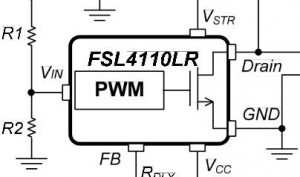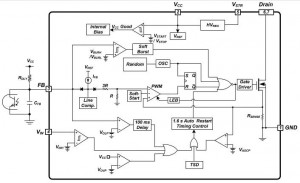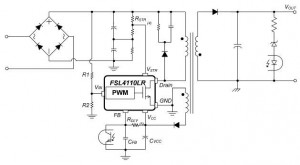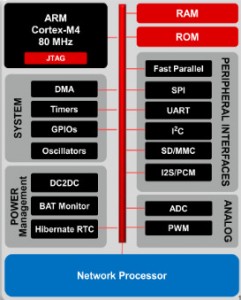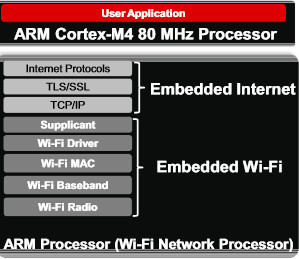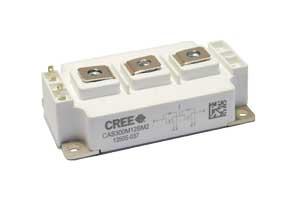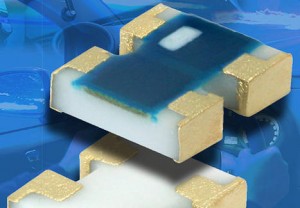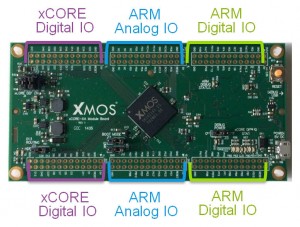 Xmos has announced development boards for its fast and novel xCore-XA microcontroller, that includes an ARM Cortex-M3 alongside its unconventional low-latency 32bit multi-core processor architecture – invented to provide fast deterministic interfacing without interrupts.
Xmos has announced development boards for its fast and novel xCore-XA microcontroller, that includes an ARM Cortex-M3 alongside its unconventional low-latency 32bit multi-core processor architecture – invented to provide fast deterministic interfacing without interrupts.
The first products aimed at flexible industrial ‘field bus’ communication.
“There are a plethora of field bus standards. A lot are emerging, and this is where the flexibility of software-defined interfacing is really useful,” Xmos product manager Peter Tasker told Electronics Weekly.
This is not the first time Xmos has tacked field bus with a development kit – there was one early in 2013 (IS-BUS sliceCARD), but this is the first to include the Cortex-M3 extension the firm announced this time last year.
It bought the Cortex-M3 in from Energy Micro (even as Energy was acquired by Silicon Labs), along with a handful of Energy’s famously low-power peripherals – including UART, GPIO and USB.
While incorporating hard peripherals went against the grain at Xmos, it gave the firm a chip that could sleep at under 1µA, clip along at 50Mips for 10mA on the ARM core, then fly instantaneously to 500Mips by engaging the proprietary xCores – all for 50mA.
“The ARM can do the easy stuff and the heavy-lifting is done by the xCores,” said Tasker.
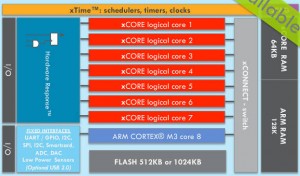 For industrial use, xCores can run the lower levels of Ethernet and CAN stacks, for example, while the Cortex-M3 handles the upper layers. Libraries are available to aid communication between the dissimilar cores, and there are stacks for CAN and Ethernet on the way.
For industrial use, xCores can run the lower levels of Ethernet and CAN stacks, for example, while the Cortex-M3 handles the upper layers. Libraries are available to aid communication between the dissimilar cores, and there are stacks for CAN and Ethernet on the way.
“Most field busses are built on Ethernet and CAN. We don’t intend to develop loads of stacks. We will have some core stuff like Ethernet and CAN, and we might partner with third-party industrial stack providers to offer their products on our silicon,” said Tasker.
And if a customer wants to develop custom lower stack levels for a different interface?
According to Tasker: “It is pretty easy to implement the low level on xCores – you don’t have to write interrupt service routings. I wrote a DMX 512 [LED lighting] controller in a few hours.”
Aren’t there already plenty of microcontrollers around with Ethernet and CAN interfaces?
Tasker questions their reliability and determinism.
“When CAN is a hard peripheral, the peripheral does the CRC [cyclic redundancy check] and passes only the packet on to the processor. In a bridge, we want to preserve CRC from end to end, all the way from CAN to Ethernet,” he said, adding: “We have implemented the AVB bus, which proves we can do determinism.”
AVB – audio video bridging – is a set of IEEE standards with rather touchy timing constraints – so much so, and in acknowledgement that the standards are reaching beyond audio and video, that the IEEE AVB task group was renamed the ‘Time-sensitive networking task group’.
For field bus there is a pair of development boards – the general-purpose xCore-XA development module – which plugs into an ‘application specific baseboard’ – in this case dedicated to industrial communication and incorporating the Ethernet PHYs. Later baseboards will be aimed at other applications.
The development module is stripped down compared with xMos’ earlier offerings.
“This is really for hard-core engineers. We have taken off some twinkling lights and push buttons in favour of giving users access to all the I/O without multiplexing to give them a flashing lights demo,” said Tasker. “There are a couple of LEDs to see if it is booting, and a reset switch.”
The top side of the general-purpose module PCB has only the components that would be needed in a final system. Underneath are development components such as the two hardware debuggers – an in-house xTag-3 for the xCores and a Segger J-Link OB for the M3. Connections are though USB and 0.1inch headers – which is still the favoured header pitch, according to Tasker.
 This plugs into the baseboard – which is physically large to improve stability when heavy field bus cables are attached.
This plugs into the baseboard – which is physically large to improve stability when heavy field bus cables are attached.
Layout is such on the general-purpose board that users can make custom baseboards using double-sided PCB rather than four layers.
Xmos also sees small interface cards being attached to the top of the general purpose module, and Tasker has some interesting plans in this direction, which Electronics Weekly cannot yet reveal.
Software tools include an integrated development environment on which ARM and xCore C-code is displayed simultaneously, and the debug tools also display simultaneously. “All these debug tools are free, and really powerful,” claimed Tasker.
Another tool, xTime composer, does static timing and has a real-time oscilloscope-like display.
Board will be available in December from distributors including Digi-Key. For an early glimps, there will be some demonstrations at ARM techCon in Santa Clara next week.
xCore-XA microcontroller modes at a glance
- Shut-down: 100nAtyp, 160us wake on GPIO or reset
- Deep-sleep: 1uAtyp, 2us wake on RTC or peripherals
- Processor-sleep: 50uAtyp, peripherals operate autonomously
- Low-power: 10mAtyp, 50Mips
Performance: 50mAtyp*, xCores engaged for 500Mips
* Assumes 3.3V source supply and dc-dc conversion loss
steve bush
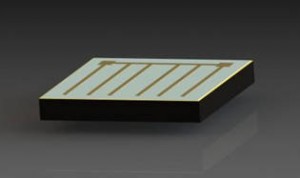 Plessey has achieved 120 lm/W efficacy and 50% efficiency (power in/out) from its GaN-on-Silicon technology.
Plessey has achieved 120 lm/W efficacy and 50% efficiency (power in/out) from its GaN-on-Silicon technology.

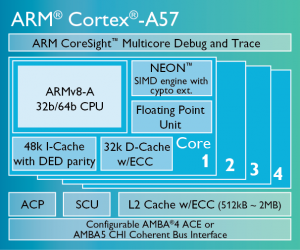 Cray
Cray